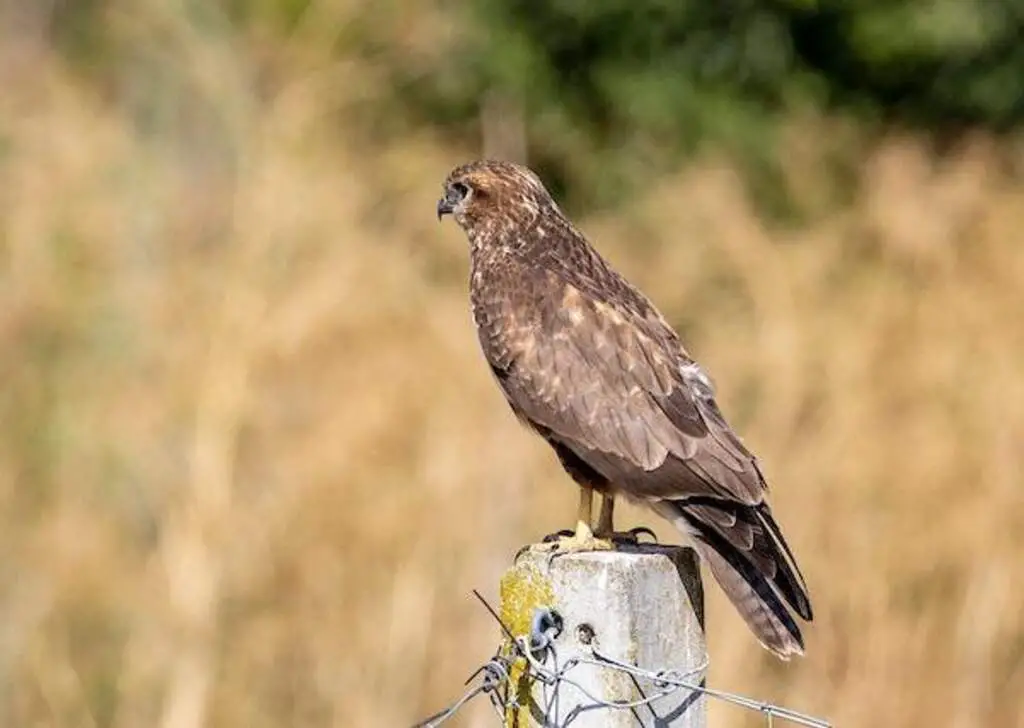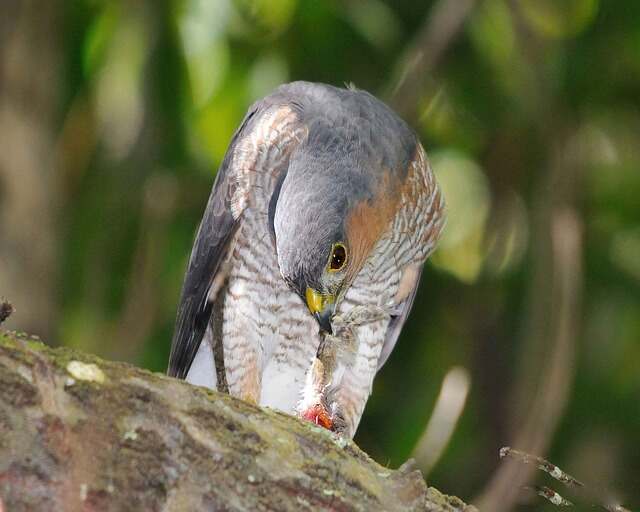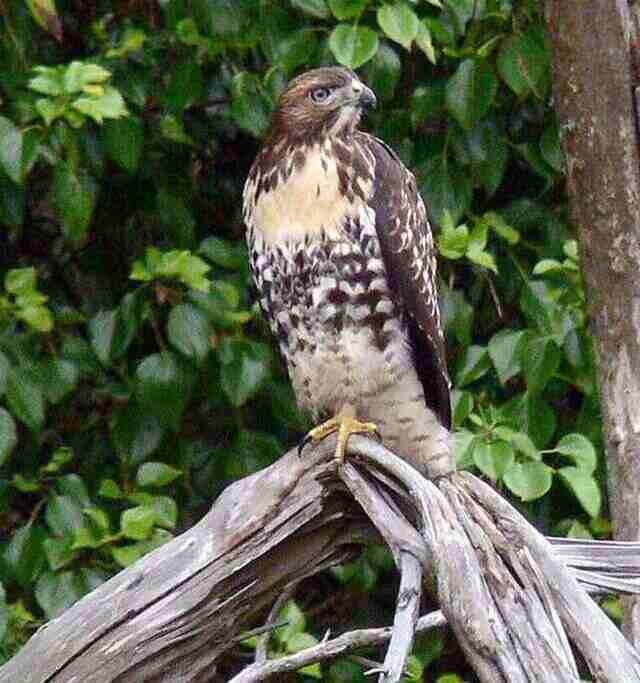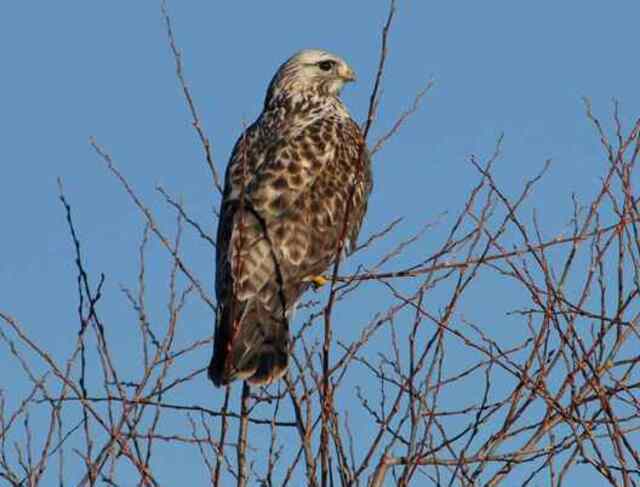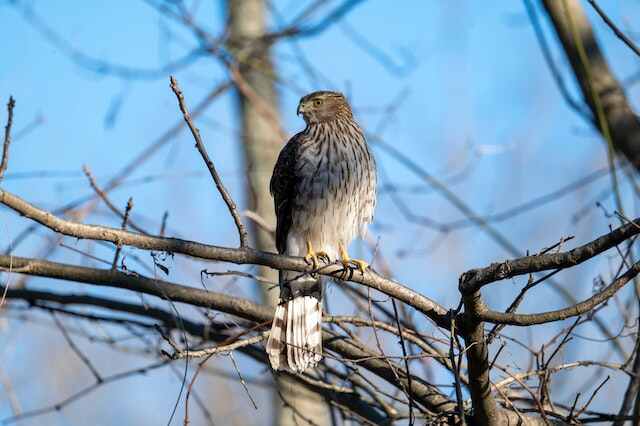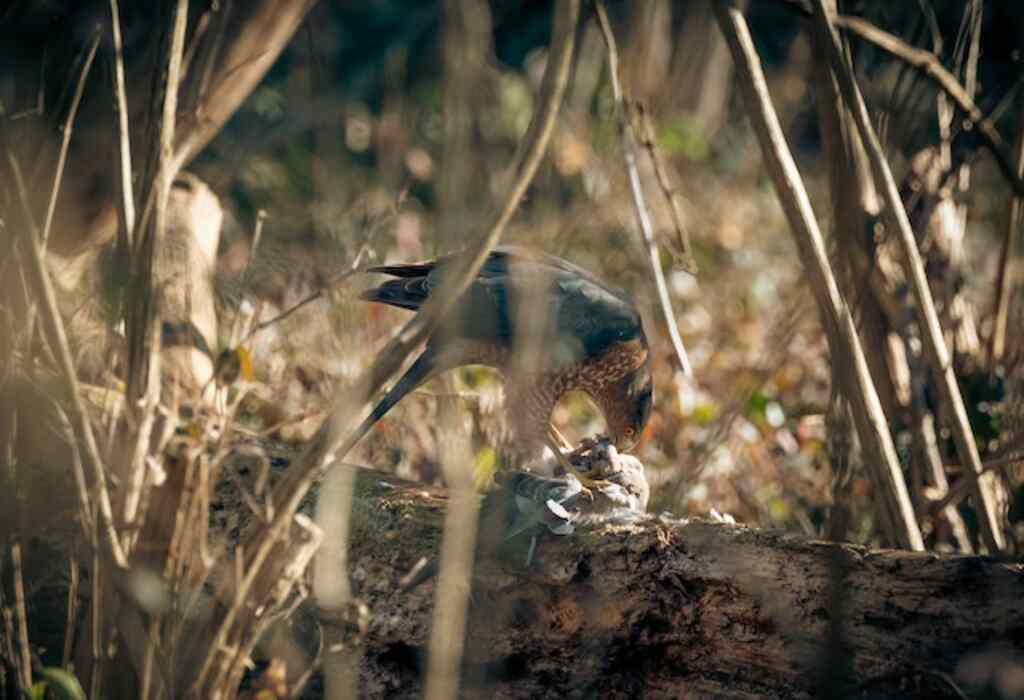Hawks are known for their sharp talons, keen eyesight, and impressive hunting skills. They are birds of prey that have been observed consuming a wide range of animals, from small rodents to large mammals. However, one prey item that has piqued the interest of many is snakes.
Do hawks eat snakes? This article explores the answer to this question and delves into the reasons why understanding the eating habits of hawks is important.
Table of Contents
- 0.1 Explanation of the Topic
- 0.2 Importance of Understanding the Eating Habits of Hawks
- 0.3 Brief Overview of What Will Be Covered in the Article
- 1 Overview of Hawks
- 2 Do Hawks Eat Snakes?
- 3 Snakes as Prey for Hawks
- 4 Nutritional Value of Snake Meat for Hawks
- 5 Unique Adaptations that Allow Hawks to Eat Snakes
- 6 Interactions between hawks and snakes in the wild
- 7 Human impact on hawk populations that eat snakes
- 8 Conclusion
- 9 FAQs: Do Hawks Eat Snakes?
- 9.1 What types of snakes do hawks eat?
- 9.2 How do hawks hunt and catch snakes?
- 9.3 Are all hawks capable of eating snakes?
- 9.4 Do hawks eat venomous snakes?
- 9.5 Are snakes a significant part of a hawk’s diet?
- 9.6 How often do hawks eat snakes?
- 9.7 Are there any risks to hawks when eating snakes?
- 9.8 Do hawks exclusively eat snakes?
- 9.9 Are hawks beneficial for controlling snake populations?
- 10 Author
Explanation of the Topic
Hawks are raptors that belong to the family Accipitridae. These birds are carnivores and are known for their sharp claws or talons, which they use for catching their prey. The diet of hawks varies depending on their natural habitat and geographic location.
Some hawk species feed primarily on small mammals such as rabbits and squirrels, while others consume insects, lizards, and even other birds. One animal that has been reported as prey for some hawk species is snakes.
Snakes can be a challenging meal for birds of prey due to their slippery skin and venomous fangs in some species.
However, some hawk species have unique adaptations that allow them to hunt and consume these slithery reptiles.
Importance of Understanding the Eating Habits of Hawks
Understanding what hawks eat is essential in comprehending how they interact with other wildlife populations in an ecosystem.
Furthermore, it provides valuable information about conservation efforts aimed at protecting these powerful predators from extinction.
Additionally, studying hawk predation patterns on different types of organisms can provide insight into predator-prey relationships within an ecosystem.
It can also help researchers identify any potential threats or imbalances in a particular ecosystem by looking at changes in hawk diet over time.
Understanding which foods hawks consume not only helps biologists make predictions about food availability for these birds, but it also has practical applications for bird watchers and other nature enthusiasts who appreciate this majestic animal’s beauty and hunting prowess.
Brief Overview of What Will Be Covered in the Article
This article will explore the question whether hawks eat snakes by examining various aspects such as hawk classification, snake predation patterns, nutritional value of snake meat for hawks, unique adaptations that allow hawks to eat snakes, interactions between hawks and snakes in the wild, and human impact on hawk populations that feed on snakes.
By the end of this article, you will have a deeper understanding of the dietary habits of hawks and how they interact with their environment.
Overview of Hawks
Hawks are birds of prey that belong to the Accipitridae family. These birds have sharp, curved beaks and powerful talons that they use to hunt and kill their prey. They are known for their keen eyesight, which allows them to spot potential prey from great distances.
There are over 250 species of hawks found throughout the world. These birds vary in size and coloration, but they all share similar characteristics.
Hawks have broad wings that allow them to soar through the air with ease. They also have strong legs and feet that enable them to grab and carry their prey.
Classification and Characteristics
Hawks are classified as raptors or birds of prey, along with eagles, owls, and falcons. They are further classified into two groups: Accipiters and Buteos.
Accipiters are small hawks with short wings that enable them to maneuver through dense forests as they hunt small birds and mammals.
Buteos are larger hawks with longer wings that allow them to soar high in the sky as they search for larger prey.
All hawks share similar characteristics such as sharp talons used for capturing prey, a hooked beak used for tearing flesh from bones, excellent eyesight used for spotting potential meals from great distances, strong wings used for soaring through the air effortlessly.
Types of Hawks Found in North America
In North America alone there are approximately 30 different species of hawks found across a diverse range of habitats such as forests, grasslands, deserts & coastal regions etc. Some common hawk species found in North America include:
Each species has its unique physical and behavioral characteristics that make it well-suited for the environment in which it lives.
The Red-tailed Hawk, for example, is a large buteo hawk that is known for its reddish-brown tail feathers.
This species can be found across the United States and is a favorite of bird watchers because of its size and striking appearance.
Habitat and Behavior
Hawks can be found in a variety of habitats including forests, grasslands, deserts & coastal regions. They prefer open areas where they have plenty of space to soar through the air as they search for prey.
Hawks are solitary birds except during the breeding season when they will form pairs. Hawks use their keen eyesight to locate prey while flying high in the sky.
Once prey is spotted, hawks will quickly descend to capture their meal with their sharp talons.
After capturing their prey, hawks will take it to a nearby perch where they can consume it without being disturbed.
Overall, hawks are fascinating birds of prey with unique physical and behavioral characteristics that allow them to thrive in diverse environments throughout North America and beyond.
Understanding their characteristics and habits is important not only for bird enthusiasts, but also for conservationists who are working to protect these magnificent birds from habitat loss and other threats.
Do Hawks Eat Snakes?
Yes, hawks do eat snakes. Hawks are birds of prey known for their hunting skills. Some hawk species have adaptations that allow them to hunt and consume snakes, despite the challenges posed by their slippery skin and venomous fangs.
Snakes provide a nutritional food source for hawks and are abundant in many habitats where hawks live. The interactions between hawks and snakes vary depending on the species and habitat.
Overall, hawks are capable predators that can catch and consume snakes as part of their diet.
Snakes as Prey for Hawks
Why snakes are a preferred food source for some hawks
Hawks are predatory birds that feed on a variety of prey items, including small mammals, birds, and reptiles. Among the reptiles, snakes are particularly popular prey for some hawk species. There are several reasons why hawks may prefer to eat snakes.
One reason is that snakes are abundant and easy to catch in many habitats where hawks live. Snakes also provide a high nutritional value for the hawk’s diet.
Another reason why hawks prefer to eat snakes is that they have relatively few natural predators in comparison to other prey items like birds or rodents.
This means that hawks can often hunt these reptiles without fear of being attacked by other animals in the process.
How hawks hunt and capture snakes
Hawk species that feed on snakes have developed specific hunting techniques to capture their prey effectively. These techniques vary depending on the species of hawk and the type of snake they target.
Some hawks will actively search for snakes while flying over open areas or perching on elevated spots such as trees or poles.
Once a hawk spots a snake, it will dive at it from above, using its sharp talons to grab onto the snake’s body while its beak delivers a lethal bite to the back of the head or neck area.
The hawk then carries its prey away from danger before consuming it whole.
Examples of hawk species known to eat snakes
There are several species of hawks found across North America, known for their preference towards eating snakes as part of their diet.
These include Red-tailed Hawks, Cooper’s Hawks, Sharp-shinned Hawks, Harris’s Hawks and Rough-legged Hawks.
Red-tailed Hawks have been observed feeding on common garter snakes (Thamnophis sirtalis), Western Diamondback Rattlesnakes (Crotalus atrox) and even giant snakes such as the Black Rat Snake (Pantherophis obsoletus).
Cooper’s Hawks are known to be opportunistic hunters, capturing prey items as diverse as birds, small mammals and reptiles.
In California, they have been observed hunting Pacific Rattlesnakes (Crotalus oreganus) and Gopher Snakes (Pituophis catenifer), which can be found in the same habitat of their preferred prey species.
Sharp-shinned Hawks mainly feed on smaller prey items like songbirds and small mammals but have also been observed feeding on juvenile snakes.
Harris’s Hawks have a unique hunting technique where several individuals work together to capture larger prey items like rabbits or snakes.
Rough-legged hawks feed on a variety of rodents and reptiles, including garter snakes.
Hawks are expert predators that have developed specific techniques to hunt and capture their preferred prey item, including snakes.
The abundance of these reptiles in many habitats combined with their high nutritional value makes them an ideal food source for several hawk species found across North America.
Nutritional Value of Snake Meat for Hawks
Understanding the Importance of a Healthy Diet for Raptors
Hawks are known to have a diverse diet, and some species can eat up to 20 different types of prey. However, not all prey items are nutritionally equal.
It is important to understand the nutritional value that snake meat provides for hawks. Snakes are a good source of protein and fat, which are essential nutrients required by hawks to maintain their health.
A diet lacking in proper nutrition can affect raptors’ growth rate, reproductive success, and ability to defend themselves against predators.
Snake meat also contains vitamins and minerals important for raptors’ overall health.
It has been found that larger snakes have higher concentrations of calcium and phosphorus in their bones than smaller snakes. These minerals play an important role in the development of healthy bones in hawks.
Analysis of Snake Meat as a Food Source for Raptors
Research has shown that snake meat is highly nutritious for raptors like hawks. A study conducted on
Cooper’s Hawks showed that snakes made up 22% of their diet during breeding season and 16% during non-breeding season.
Another study on Red-tailed Hawks found that snakes only made up 5% of their diet but were consumed more frequently during the summer months.
The analysis also shows that snakes are high in energy density compared to other prey items commonly consumed by hawks, such as rodents and birds.
This means that consuming snake meat allows hawks to obtain more calories per gram than eating other prey items.
Comparison with Other Common Prey Items Consumed by Raptors
While snake meat provides significant nutritional benefits for hawks, it is important to compare its benefits with other commonly consumed prey items like rodents and birds.
Rodents like mice and voles are good sources of protein for hawks, but they are also high in fat. Overconsumption of these prey items can lead to obesity and other health issues.
Birds are also a good source of protein for hawks, but not all species provide the same nutritional value.
For example, larger birds like ducks and geese have higher protein and energy density compared to smaller birds like sparrows.
Overall, while snake meat is not the only food source that provides essential nutrients for hawks, it is a valuable addition to their diet.
The high nutritional value and energy density make it an ideal food item for raptors like hawks.
Unique Adaptations that Allow Hawks to Eat Snakes
Specific Physical Adaptations that Help Them Consume Their Prey
Hawks are known for their sharp talons and beaks, which are essential for taking down and consuming prey.
However, when it comes to eating snakes, hawks have developed some unique physical adaptations that help them consume these slippery creatures. One of the most notable adaptations is their flexible necks.
Unlike humans and many other animals, hawks have an incredible range of motion in their necks, allowing them to bend and twist in ways that would be impossible for us. This flexibility enables hawks to maneuver around a snake’s body as they grip it with their talons, making it easier for them to swallow the snake whole.
In addition to their flexible necks, hawks also have specialized digestive systems that allow them to process and break down snake meat efficiently.
For example, they have strong stomach acids that can dissolve the tough scales and bones of a snake’s body.
They also have a “crop,” which is a specialized pouch in their throat where food can be stored temporarily before being digested.
This allows hawks to swallow large prey items like snakes without choking or injuring themselves.
Behavioral Adaptations That Aid in Hunting and Consuming Snakes
Hunting snakes requires a different set of skills than hunting other types of prey due to the unique physical characteristics of snakes.
To catch a snake, a hawk must first locate its hiding spot or resting place; this requires excellent eyesight and keen observation skills.
Once the hawk has spotted its target, it will often swoop down from above at high speeds—a hunting strategy known as “stooping.”
This tactic allows the hawk to surprise its prey and quickly seize it with its talons. Once caught, the hawk must then deal with the challenge of consuming the snake.
To do this, hawks have developed several unique behavioral adaptations. For one, they will often carry the snake to a high perch where they can safely consume it without interruption.
This also allows the hawk to tear off bite-sized pieces of meat more easily, rather than trying to swallow the whole snake at once.
Another behavioral adaptation is that hawks will often shake their prey vigorously before consuming it.
This shaking motion helps to dislodge any remaining scales or bones, making it easier for the hawk to swallow the meat.
Overall, these physical and behavioral adaptations help hawks to make quick work of their slippery prey and ensure that they get all the nutrients they need from their meals.
Interactions between hawks and snakes in the wild
How do these two predators interact with each other?
Hawks and snakes are both predators that occupy similar ecological niches, meaning that they can sometimes come into contact with each other in the wild.
The interactions between these two animals can vary depending on the species of hawk and snake involved, as well as the habitat and behavior of each animal.
In some cases, hawks may prey on snakes, while in others, the two animals may avoid each other altogether.
One example of an interaction between hawks and snakes is when a hawk attempts to catch a snake as prey.
Hawks have several adaptations that allow them to capture and kill snakes, such as sharp talons for grasping their prey and a hooked beak for tearing flesh.
However, catching a snake can also be risky for a hawk since some species of snakes are venomous and can defend themselves against predators.
Another type of interaction occurs when both hawks and snakes occupy the same habitat but do not directly interact with each other.
For example, in areas where both animals live near water sources like ponds or rivers, they may coexist without ever coming into contact.
Hawks may hunt fish or small mammals around these water sources, while avoiding areas where snakes are known to congregate.
How do they avoid each other?
Both hawks and snakes have evolved various strategies to avoid or deter potential predators. For example, some species of hawk have developed intricate hunting techniques that allow them to catch prey without being detected by potential threats such as snakes.
This includes using stealthy approaches from above or diving onto their prey at high speeds.
On the other hand, certain types of snake have evolved defensive mechanisms that help them avoid being eaten by birds like hawks.
For instance, some species have developed camouflage patterns on their skin that blend in with their surroundings, making them harder to spot.
Other snakes have developed warning signals such as bright colors or loud hissing noises that indicate they are dangerous and should be avoided.
In addition, some hawks and snakes have overlapping territories but avoid each other by occupying different parts of the habitat.
For example, some species of hawks prefer to hunt in open fields while avoiding wooded areas where snakes may be hiding.
By staying in different parts of the habitat, both predators can coexist without competing for resources or coming into contact with each other.
Overall, the interactions between hawks and snakes in the wild can vary widely depending on the specific species involved as well as a variety of ecological factors.
Despite these differences, both animals play important roles in maintaining healthy ecosystems and are fascinating predators to study and observe in their natural habitats.
Human impact on hawk populations that eat snakes
The impact of habitat loss and fragmentation
One of the biggest threats to hawks that eat snakes is habitat loss and fragmentation.
As human development increases, natural habitats become smaller and more fragmented, making it harder for hawks to find suitable prey.
This can lead to a decline in hawk populations over time. Additionally, some human activities such as logging or mining can destroy important habitats altogether.
Pesticides and other toxins
Another major threat to hawks that eat snakes is exposure to pesticides and other toxins.
Many farmers use pesticides on crops to protect them from pests, but these chemicals can also harm non-target species like hawks by contaminating their food sources.
Ingesting these toxins can lead to illness or death in both adult birds and their offspring.
Illegal hunting
Illegal hunting is also a significant threat to hawk populations that eat snakes. Some people hunt birds of prey for sport or because they perceive them as a threat to livestock or game animals.
This type of hunting not only harms individual birds but also reduces the overall population size over time.
Conservation efforts
Fortunately, there are several conservation efforts underway aimed at protecting hawks that eat snakes and their habitats.
For example, some organizations work with farmers to reduce pesticide use on crops in order to minimize unintentional harm to wildlife.
Other groups focus on habitat restoration projects designed specifically for hawks or other birds of prey.
Conclusion
While there are certainly threats facing hawk populations that consume snakes, there is hope for their continued survival if we take action now.
By working together through conservation efforts, we can reduce the impact of habitat loss and fragmentation, minimize exposure to toxins, and prevent illegal hunting practices.
This collaborative approach ensures healthy populations of these vital predator species for generations to come.
FAQs: Do Hawks Eat Snakes?
What types of snakes do hawks eat?
Hawks are opportunistic predators and can feed on various snake species. Their diet may include garter snakes, rat snakes, water snakes, and even small venomous snakes like copperheads or rattlesnakes, depending on the hawk’s size and hunting abilities.
How do hawks hunt and catch snakes?
Hawks employ various hunting techniques to capture snakes. With their keen vision, hawks scan the ground from above, detecting snakes with precision. Swiftly, they dive down and seize their prey using their formidable talons. Some hawks may also ambush snakes by waiting near their hiding spots or pouncing on them from the ground.
Are all hawks capable of eating snakes?
While most hawk species are capable of catching and consuming snakes, their diet primarily depends on their size, hunting skills, and geographical location. Smaller hawk species may focus on smaller prey, while larger hawks have the ability to tackle larger snakes.
Do hawks eat venomous snakes?
Yes, some hawks are known to prey on venomous snakes. However, they have developed techniques to minimize the risk of being bitten. They often grab the snake behind the head, where it cannot bite, or they may use their wings to shield themselves from potential strikes.
Are snakes a significant part of a hawk’s diet?
The significance of snakes in a hawk’s diet can vary based on their specific habitat and prey availability. While snakes are an important food source for many hawks, they may also consume a variety of other prey, including small mammals, birds, insects, and amphibians.
How often do hawks eat snakes?
The frequency of hawks consuming snakes depends on factors like the availability of snakes in their habitat and the nutritional requirements of the hawk species. Hawks typically feed on a daily basis, so if snakes are abundant, they may consume them regularly.
Are there any risks to hawks when eating snakes?
Eating snakes can pose certain risks to hawks, especially if the snake is venomous. However, hawks have developed adaptations to minimize these risks, such as targeting the head to avoid being bitten. Additionally, their feathers provide some protection against the snake’s fangs.
Do hawks exclusively eat snakes?
No, hawks are opportunistic hunters and have a diverse diet. While snakes can be a significant part of their diet, hawks also consume a range of other prey, including rodents, birds, reptiles, amphibians, and insects, depending on their habitat and prey availability.
Are hawks beneficial for controlling snake populations?
Yes, hawks play a crucial role in maintaining ecological balance by controlling snake populations. By preying on snakes, hawks help regulate their numbers, which can be essential for managing potential threats or imbalances in ecosystems where snakes are present.

